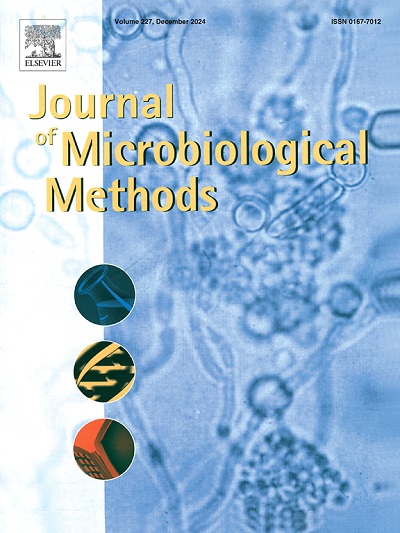快速药敏试验(RAST)对阳性血培养瓶早期传代生长的影响
IF 1.9
4区 生物学
Q4 BIOCHEMICAL RESEARCH METHODS
引用次数: 0
摘要
血培养中分离细菌的抗菌药敏试验(AST)对脓毒症患者的管理至关重要。AST的分离和执行标准周转时间(TAT)约为48-96 h。本研究计划评估快速抗菌药敏试验(RAST)对阳性血培养瓶(PBCB)早期传代(s/c)生长的性能,并将其与标准24 h (h)生长进行比较。对阳性血培养瓶(PBCB)在三组板上进行s/c染色,在370C下孵育4、8和24小时。在4、8和24小时后检查每个板的生长情况,在每个板上进行AST检测,并在4、8和24小时后读取每个板的AST。其中,革兰氏阴性杆菌(GNB)占84.4%(136/161),革兰氏阳性球菌(GPC)占15.5%(25/161)。我们的研究结果表明,大肠杆菌、肺炎克雷伯菌、不动杆菌种、粘质沙雷菌和肠杆菌种在生长4 h时可获得可解释的AST结果。铜绿假单胞菌、洋葱伯克霍尔德菌复合菌和嗜麦芽窄养单胞菌在生长8 h时可获得可解释的AST结果,其AST在4 h时可读取。无色杆菌和拉尔斯顿菌在s/c生长24 h时可获得可解释的RAST结果,其AST在4 h时读取。从s/c生长早期进行RAST测试可以降低AST结果的TAT。本文章由计算机程序翻译,如有差异,请以英文原文为准。
Evaluation of Rapid antimicrobial susceptibility testing (RAST) by disk diffusion on early subculture growth from positive blood culture bottles
Antimicrobial susceptibility testing (AST) of bacteria isolated in blood cultures is critical for management of patients with sepsis. Standard turnaround time (TAT) to isolate and perform AST is around 48–96 h. This study was planned to evaluate the performance of rapid antimicrobial susceptibility testing (RAST) on early subculture (s/c) growth of positive blood culture bottle (PBCB) and compare this with standard 24 h (h) growth. Gram stain along with s/c was done for positive blood culture bottle (PBCB) in three sets of plates that were incubated at 370C for 4,8 and 24 h. Each plate was examined for growth after 4, 8 and 24 h and AST was performed from each plate and was read after 4, 8 and 24 h for each plate. Out of 161 isolates, 84.4 % (136/161) isolates were gram-negative bacilli (GNB) and15.5 % (25/161) were identified as gram-positive cocci (GPC). Our study results showed that interpretable RAST results for Escherichia coli,Klebsiella pneumoniae,Acinetobacter species, Serratia marcescens and Enterobacter species could be achieved for 4 h s/c growth whose AST is read at 4 h. For Pseudomonas aeruginosa, Burkholderia cepacia complex and Stenotrophomonas maltophilia interpretable RAST results could be achieved for 8 h s/c growth whose AST is read at 4 h. For Staphylococcus species, Enterococcus species, Ochrobactrum, Achromobacter and Ralstonia species interpretable RAST results could be achieved for 24 h s/c growth whose AST is read at 4 h. RAST testing from the early s/c growth can be performed to decrease the TAT of AST results.
求助全文
通过发布文献求助,成功后即可免费获取论文全文。
去求助
来源期刊

Journal of microbiological methods
生物-生化研究方法
CiteScore
4.30
自引率
4.50%
发文量
151
审稿时长
29 days
期刊介绍:
The Journal of Microbiological Methods publishes scholarly and original articles, notes and review articles. These articles must include novel and/or state-of-the-art methods, or significant improvements to existing methods. Novel and innovative applications of current methods that are validated and useful will also be published. JMM strives for scholarship, innovation and excellence. This demands scientific rigour, the best available methods and technologies, correctly replicated experiments/tests, the inclusion of proper controls, calibrations, and the correct statistical analysis. The presentation of the data must support the interpretation of the method/approach.
All aspects of microbiology are covered, except virology. These include agricultural microbiology, applied and environmental microbiology, bioassays, bioinformatics, biotechnology, biochemical microbiology, clinical microbiology, diagnostics, food monitoring and quality control microbiology, microbial genetics and genomics, geomicrobiology, microbiome methods regardless of habitat, high through-put sequencing methods and analysis, microbial pathogenesis and host responses, metabolomics, metagenomics, metaproteomics, microbial ecology and diversity, microbial physiology, microbial ultra-structure, microscopic and imaging methods, molecular microbiology, mycology, novel mathematical microbiology and modelling, parasitology, plant-microbe interactions, protein markers/profiles, proteomics, pyrosequencing, public health microbiology, radioisotopes applied to microbiology, robotics applied to microbiological methods,rumen microbiology, microbiological methods for space missions and extreme environments, sampling methods and samplers, soil and sediment microbiology, transcriptomics, veterinary microbiology, sero-diagnostics and typing/identification.
 求助内容:
求助内容: 应助结果提醒方式:
应助结果提醒方式:


